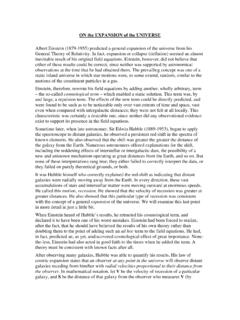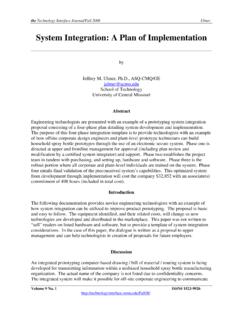Transcription of Proposed 5 Year Plan: System Benefits and Implementation ...
1 Approved for Public Release11 National Aeronautics and Space Engine ControlProposed 5 Year Plan: System Benefits and Implementation Challenges2009 Propulsion Controls and Diagnostics WorkshopDecember 8-10, 2009 Industry RepresentativesDistributed Engine Control Working GroupApproved for Public Release2 Approved for Public Release2 Originally presented at the 45thAIAA/ASME/SAE/ASEE Joint Propulsion Conference & Exhibit4 August 2009 Colorado Convention CenterDenver, ColoradoA Subset of the Panel Discussion onApproved for Public Release3 Approved for Public Release3 Originally Developed by Panel MembersBruce Wood.
2 Pratt & WhitneyDerek Weber, Inprox TechnologyBill Rhoden, Hamilton-SundstrandBill Mailander, GE AviationGary Hunter, NASA Glenn Research CenterDennis Culley, NASA Glenn Research CenterCasey Carter, BAE SystemsDewey Benson, HoneywellAl Behbahani, Air Force Research LaboratoryApproved for Public Release4 Approved for Public Release4 Outline Vision & Need for Future Turbine Engine Control Implementation & Technical Challenges Summary & Future PlansApproved for Public Release5 Approved for Public Release5 Traditional Centralized ArchitectureApproved for Public Release6 Approved for Public Release6 Example of distributed Architecture TIM_____TIM_____TIM_____TIM_____TIM_____ TIM_____TIM_____TIM_____SmartNodeApprove d for Public Release77 Bruce WoodBrian EastonPratt & Whitney Bill
3 MailanderGE AviationAlireza BehbahaniAir Force Research LaboratoryApproved for Public Release8 Approved for Public Release8 Technical Requirements for distributed Controls Physical Drivers for New Control System Designs Thermal Environment Externals Packaging Rapid Reconfiguration / Upgradability Generic Physical/Functional Interface Environmental Requirements Certification Impact Integration Testing Financial ResponsibilityFocus on Near-Term Applications Concentrate on commercial applications with production volumes Design for maximum leveraging though multiple applicationsApproved for Public Release9 Approved for Public Release9 Technical Requirements for distributed Controls Thermal Environment Design electronics to withstand existing hardware thermal conditions Recognize limitations of typical industry materials Aluminums (300F/149C), Elastomers (350F/177F)
4 Externals Packaging Need to integrate electronics onto or within existing hardware Minimize unique hardware Adding new/extra mounting hardware drives cost, weight in the wrong directionApproved for Public Release10 Approved for Public Release10 Technical Requirements for distributed Controls Rapid Reconfiguration / Upgradability Should be able to specify same part number DCM for multiple applications Design DCM internal gains such that they can be varied without hardware changesGeneric Physical/Functional Interface Similar to the way EHSV interfaces are controlled today (ARP490)
5 Bolt/connector interfaces should be standardized Standard functionality, memory, loop closure, communication bit structure, for Public Release11 Approved for Public Release11 Technical Requirements for distributed Controls Environmental Requirements Design for existing ambient temperatures and vibration environments Don t drive cost/complexity into the DCM to withstand unrealistic margins Focus on actual engine environments, not D0160/810 generic requirementsCertification Impact, Changes to Testing Allow certification at modular level Require System level certification using black box approach to testing Allow flexible System expansion/contraction without recert.
6 RequiredApproved for Public Release12 Approved for Public Release12 Technical Requirements for distributed Controls Integration testing System integration testing paradigms will shift System integration tasks will shift one layer down the food chain AS/OS boundaries may drive testing location, integration responsibilitiesFinancial responsibility Need to keep focused on cost of products, don t design and build beyond our minimum needs (with reasonable margins) System costs need to make the case for this new technology Individual component costs are flexible Design + Development + Certification + Procurement + Life Cycle Cost = Net Savings for our CustomersApproved for Public Release13 Approved for Public Release13 Economic Drivers for New FADEC DesignsFADECs Have Unique Electronics Hardware RequirementsIssues High Temperature Capable Electronics for FADECs Are Specialty Items ~20 Years FADEC Production Runs vs.
7 Rapid Consumer Electronics Turnover FADEC Electronics Often Nearing Obsolescence At Entry Into Service Out-of- plan FADEC Obsolescence Turns Are Major Budget ChallengeImplications for Future FADECs Improved Methods for Enabling Electronics to Tolerate Engine Environment Use of Common FADEC Electronics Components Supply Base Exploration of Boutique Manufacturing Supporting Small Quantity ElectronicsNeed Broadly Applicable High Temperature Electronics Supply BaseApproved for Public Release14 Approved for Public Release14 Point-Design FADECs Don t Support Reuse / UpgradabilityEconomic Drivers for New FADEC DesignsNot Realizing Cost Benefits from Reuse / UpgradabilityIssues Point-Designs Typically Increase Initial Cost and Reduce Production Costs Upgrades Can Cost As Much As Original FADEC Implementation FADECs Are Not Designed with Reuse in Mind No Pay-It -Forward Implications for Future FADECs Need to Consider Life Cycle Business Case in Design Partitioned Architectures Limiting Necessary Re-Validation Modular and Reconfigurable FADEC Components / ArchitecturesApproved for
8 Public Release15 Approved for Public Release15 Economic Drivers for New FADEC DesignsFADEC Implementation Time Pacing Engine DevelopmentIssues FADEC Definition Usually Lags Engine Definition in Preliminary Design Long Development and Validation Times Consumed by for FADECs Weight / Cost Reduction Campaigns Drive FADEC IterationsImplications for Future FADECs Move Away From Point-Design FADECs Leverage Common FADEC Components / Modules Safety First / Understand Trades Cost and Weight Trades Modular FADEC Designs Favor Rapid Implementation Approved for Public Release16 Approved for Public Release16 The Process for distributed ControlsTechnologyInsertionSystemsEnd-Us ersProductionResearchApproved for Public Release17 Approved for Public Release17 Objective.
9 Modular, Open, distributed Engine ControlIncr eased Per for mance Reduction in engine weight due to digital signaling, lower wire/connector count, reduced cooling need 5% increase in thrust-to-weight ratioImpr oved Mission Success System availability improvement due to automated fault isolation, reduced maintenance time, modular LRU 10% increase in System availabilityLower Life Cycle Cost Reduced cycle time for design, manufacture, V&V Reduced component and maintenance costs via cross-platform commonality, obsolescence mitigation Flexible upgrade path through open interface standardsOpen Systems Development.
10 Modeling & Design Future systems requirements definition Open industry interface standards definition System modeling tools development Modular System integration and test techniquesHar dwar e Systems Development High temperature integrated circuits and systems development Improved electronic component availability Softwar e Systems Development Software System partitioning Software design and modular test capability Software distributed System V&VApproved for Public Release18 Approved for Public Release18 AirframeManufacturerWho Is The Customer For Controls?













